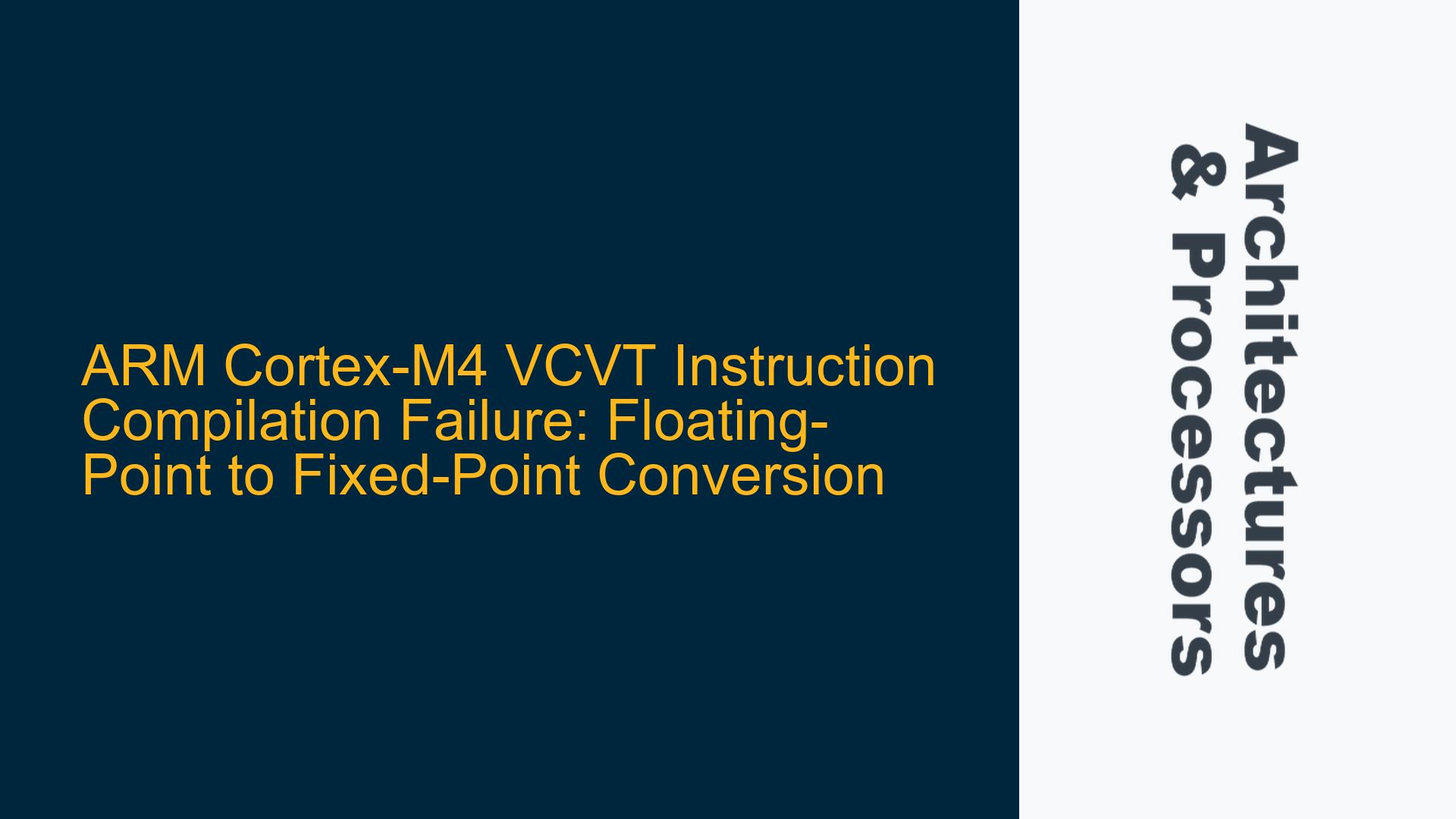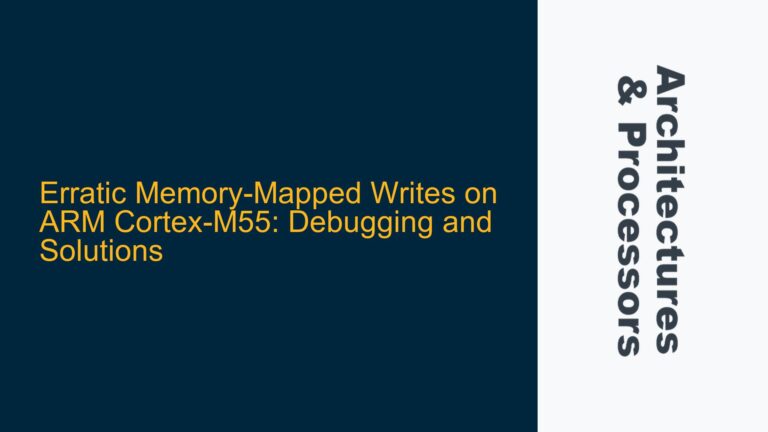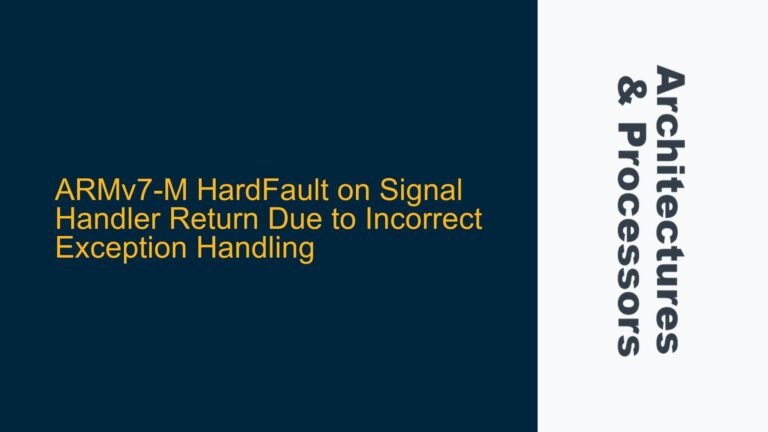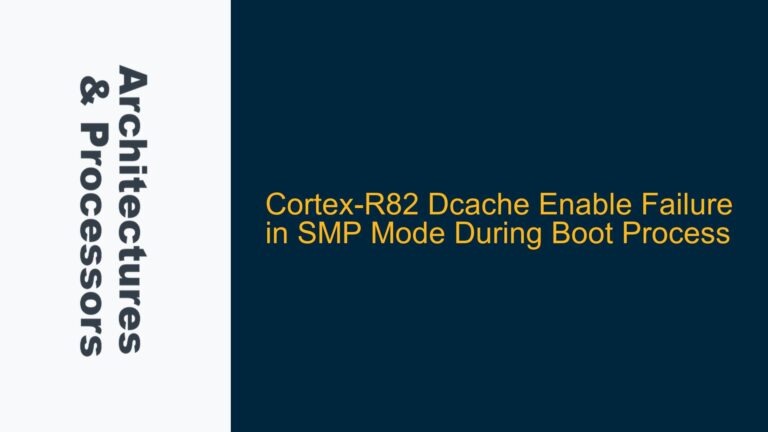ARM Cortex-M4 VCVT Floating-Point to Fixed-Point Conversion Syntax Issue
The ARM Cortex-M4 processor, equipped with a Floating-Point Unit (FPU), provides robust support for floating-point operations, including the conversion between floating-point and fixed-point representations. The VCVT instruction is a critical component of this functionality, enabling developers to perform these conversions efficiently. However, a specific issue arises when attempting to compile the VCVT instruction for floating-point to fixed-point conversion using the ARM compiler (versions 5 and 6). The instruction VCVT{cond}.S32.F32 Sd, Sd, #fbits fails to compile, despite being documented in the ARM Keil manual. This issue is not observed when compiling the same instruction with GCC, suggesting a potential bug or syntax discrepancy in the ARM compiler.
The VCVT instruction is designed to convert a floating-point value in a single-precision register (Sd) to a fixed-point representation with a specified number of fractional bits (#fbits). The syntax VCVT{cond}.S32.F32 Sd, Sd, #fbits is intended to perform this conversion, where {cond} is an optional condition code, .S32.F32 specifies the conversion from single-precision floating-point to 32-bit signed integer, and #fbits defines the number of fractional bits in the fixed-point representation. The failure to compile this instruction in the ARM compiler raises questions about the compiler’s adherence to the documented syntax and its compatibility with the Cortex-M4 FPU.
ARM Compiler Syntax Discrepancy and Potential Bug
The root cause of the compilation failure appears to be a discrepancy in the ARM compiler’s interpretation of the VCVT instruction syntax. While the ARM Keil documentation explicitly supports the VCVT{cond}.S32.F32 Sd, Sd, #fbits syntax, the ARM compiler (versions 5 and 6) rejects this syntax, indicating a potential bug or incomplete implementation. This issue is further corroborated by the observation that GCC, an alternative compiler, successfully compiles the same instruction without errors. The discrepancy suggests that the ARM compiler may not fully support the floating-point to fixed-point conversion syntax for the Cortex-M4 FPU, despite its presence in the documentation.
Another possible cause is the ARM compiler’s handling of the #fbits operand. The #fbits operand specifies the number of fractional bits in the fixed-point representation, and its value must be within the range supported by the Cortex-M4 FPU. If the ARM compiler incorrectly interprets or validates the #fbits operand, it could lead to compilation errors. Additionally, the ARM compiler’s internal parsing logic for the VCVT instruction may differ from the documented syntax, causing it to reject valid instructions. This issue is not limited to the Cortex-M4; it has also been reported for Cortex-A processors, indicating a broader problem with the ARM compiler’s support for the VCVT instruction.
Resolving VCVT Compilation Errors with Alternative Syntax and Compiler Updates
To address the VCVT compilation issue, developers can employ several troubleshooting steps and solutions. First, it is essential to verify that the ARM compiler version being used is up-to-date. ARM periodically releases updates and patches for its compilers, and a newer version may resolve the syntax discrepancy. If updating the compiler does not resolve the issue, developers can experiment with alternative syntax for the VCVT instruction. For example, using a different combination of operands or explicitly specifying the condition code may help the ARM compiler correctly interpret the instruction.
Another approach is to use inline assembly to directly embed the VCVT instruction in the code. Inline assembly allows developers to bypass the compiler’s parsing logic and directly specify the instruction in its raw form. This method can be particularly useful when dealing with compiler bugs or unsupported syntax. However, it requires a deep understanding of ARM assembly language and careful handling of register usage to avoid conflicts with the compiler’s generated code.
If the ARM compiler continues to reject the VCVT instruction, developers can consider switching to GCC or another compatible compiler that supports the required syntax. GCC has demonstrated consistent support for the VCVT instruction, making it a reliable alternative for projects that require floating-point to fixed-point conversion on the Cortex-M4 FPU. However, switching compilers may introduce additional complexities, such as differences in optimization settings, library support, and debugging tools, which must be carefully managed.
In cases where switching compilers is not feasible, developers can implement the floating-point to fixed-point conversion manually using a combination of arithmetic operations and bit manipulation. While this approach may be less efficient than using the VCVT instruction, it provides a workaround that is compatible with the ARM compiler. For example, multiplying the floating-point value by a scaling factor (2^fbits) and then casting the result to an integer can achieve the desired conversion. This method requires careful handling of rounding and overflow conditions to ensure accurate results.
Finally, developers should report the issue to ARM through official support channels. Providing detailed information about the compilation error, including the exact syntax used, the compiler version, and the target processor, can help ARM identify and address the bug in future compiler releases. Community forums and discussion threads, such as the one referenced, can also serve as valuable resources for sharing workarounds and tracking the status of the issue.
In conclusion, the VCVT instruction compilation failure on the ARM Cortex-M4 FPU highlights a potential bug or syntax discrepancy in the ARM compiler. By understanding the root cause, exploring alternative syntax, and leveraging workarounds such as inline assembly or manual conversion, developers can overcome this issue and continue to utilize the Cortex-M4 FPU’s capabilities effectively. Keeping the compiler updated and engaging with the ARM community can further aid in resolving this and similar issues in the future.






